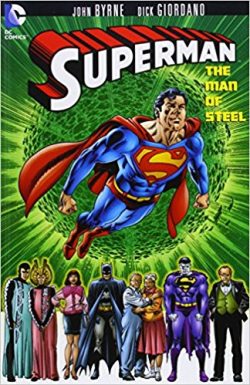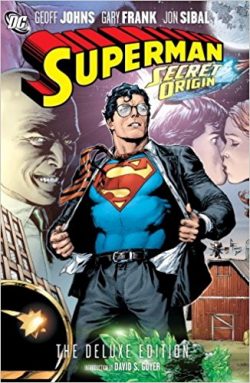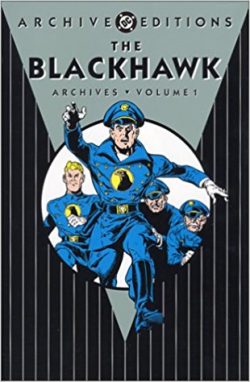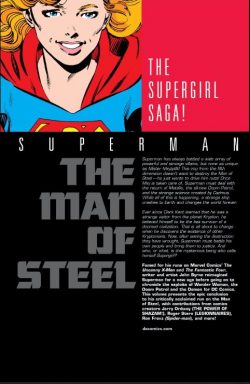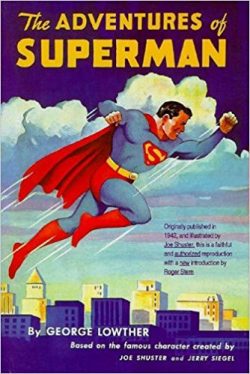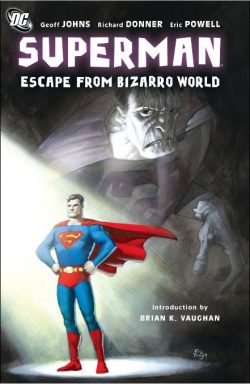
By Otto Binder, Jerry Siegel, Edmond Hamilton, Al Plastino, Curt Swan, John Forte, Jim Mooney & various (DC Comics)
ISBN: 978-1-56389-020-8
Once upon a time, in the far future, a band of super-powered kids from dozens of alien civilisations took inspiration from the legend of the greatest champion of all time and formed a club of heroes. One day those Children of Tomorrow came back in time and invited that legend to join them…
And thus began the vast and epic saga of the Legion of Super-Heroes, as first envisioned by writer Otto Binder and artist Al Plastino in early 1958, just as the revived comicbook genre of superheroes was gathering an inexorable head of steam. Since that time the popularity of the Legion has perpetually waxed and waned, with their complex continuity continually tweaked and rebooted, retconned and overwritten again and again to comply with editorial diktat and popular whim.
We Silver Age Legion fans are indubitably the most persistent, passionate, finicky and snitty of all – and editors crossed us at their peril – so when DC announced that it would be gathering all the titanic team’s appearances in a chronological series of deluxe hardcover Archive Editions we were overjoyed (actually most of us thought it was about time and long overdue…) and eager.
Sadly, even in this anniversary year those stories are no longer all in print, but at least old editions like this one from 1997 can still be found if you look hard enough. You’d think in the advanced world of the 21st century a popular series about the future would be available digitally, but you’d be wrong…
Spanning 1958-1963, this glorious full-colour compendium assembles the numerous and far-ranging preliminary appearances of these valiant Tomorrow People and their inevitable progress towards and attainment of their own feature; specifically, all pertinent material from Adventure Comics #247, 267, 282, 290, 293, and 300-305; Action Comics #267, 276, 287 and 289; Superboy #86, 89, 98 and Superman #147.
Also included are an introduction by editor, publisher and devotee Mike Gold, creator biographies and a Curt Swan cover gallery (all inked by either Stan Kaye or George Klein) featuring all the burgeoning band of brothers’ pole positions from those comics.
The multi-hued mob of universe-savers first manifested in Adventure Comics #247 (April 1958) in a Superboy tale wherein three mysterious kids – Lightning Lad, Saturn Girl and Cosmic Boy – invited the bemused Boy of Steel to visit the 30th century and join their team of metahuman champions: all originally inspired by his historic career.
Created by Otto Binder & Al Plastino, the throwaway concept inflamed public imagination and after a slew of further appearances throughout Superman Family titles, the LSH eventually took over Superboy’s lead spot in Adventure for their own far-flung, quirky escapades, with the Caped Kid Kryptonian reduced to simply a face in the in-crowd…
Here, however, the excitement was still gradually building when the kids returned more than 18 months later in Adventure #267 (December 1959) for Jerry Siegel & George Papp to play with.
In ‘Prisoner of the Super-Heroes!‘ the teen wonders reappear to attack and incarcerate the Boy of Steel because of a misunderstood ancient historical record…
The following summer Supergirl met the Legion in Action Comics #267 (August 1960, by Siegel & Jim Mooney) as Lightning Lad, Saturn Girl and Cosmic Boy secretly voyage to modern day America to similarly invite the Maid of Might to join, in a repetition of their offer to Superboy 15 years previously (in nit-picking fact, they claimed to be the children of the original team – a fact glossed over and forgotten these days: don’t time-travel stories make your head hurt…?).
Due to a dubious technicality, young and eager Kara Zor-El fails her initiation at the hands of ‘The Three Super-Heroes’ and was regretfully required to reapply later – but at least we got to meet a few more Legionnaires, including Chameleon Boy, Invisible Kid and Colossal Boy…
With the editors still cautiously testing the waters, it was January 1961 and Superboy #86 before the ‘The Army of Living Kryptonite Men!’ (by Siegel & Papp) turn the LSH into a last-minute Deus ex Machina to save the Smallville Sentinel from juvenile delinquent Lex Luthor‘s most insidious assault.
Two months later in Adventure #282, Binder & Papp introduce Star Boy as a romantic rival for the Last Son of Krypton in ‘Lana Lang and the Legion of Super-Heroes!’
Action #276 (May 1961) then debuted ‘Supergirl’s Three Super Girl-Friends’ (Siegel & Mooney, which finally sees her crack the plasti-glass ceiling and successfully enlist, sponsored by Saturn Girl, Phantom Girl and Triplicate Girl.
We also meet for the first time Bouncing Boy, Shrinking Violet, Sun Boy and potential bad-boy love-interest Brainiac 5 (well at least his distant ancestor Brainiac was a very bad boy…)
Next comes pivotal two-part tale ‘Superboy’s Big Brother’ (by Robert Bernstein & Papp from Superboy #89; June 1961) in which an amnesiac, super-powered space traveller crashes in Smallville, speaking Kryptonese and carrying star-maps written by the Boy of Steel’s long-dead father…
Jubilant, baffled and suspicious in equal amounts Superboy eventually, tragically discovers ‘The Secret of Mon-El’ by accidentally exposing the stranger to a lingering, inexorable death, before desperately providing critical life-support by depositing the dying alien in the Phantom Zone until a cure can be found…
With an August 1961 cover-date, Superman #147 unleashed ‘The Legion of Super-Villains’ (by Siegel, Curt Swan & Sheldon Moldoff): a stand-out thriller featuring Lex Luthor and the adult adversary Legion coming far too close to destroying the Action Ace until the temporal cavalry arrive…
Adventure #290 (November 1961, Bernstein & Papp) seemingly gave Sun Boy a starring role in ‘The Secret of the Seventh Super-Hero!’ – a clever tale of redemption and second chances, followed in #293 (February 1962) by a gripping thriller from Siegel, Swan & George Klein: ‘The Legion of Super-Traitors!’
Here the future heroes are turned evil, prompting Saturn Girl to recruit a Legion of Super-Pets including Krypto, Streaky the Super Cat, Beppo, the monkey from Krypton and Comet the magical Super-horse to save the world – and yes, I typed all that with a (reasonably) straight face…
Siegel & Mooney’s ‘Supergirl’s Greatest Challenge!’ (Action #287, April 1962) has her visit the Legion (quibblers be warned: it is mistakenly described as the 21st century in this story) to save future Earth from invasion. She also meets a telepathic descendent of her cat Streaky. His perhaps ill-considered name was Whizzy…
Action #289 featured ‘Superman’s Super-Courtship!’ wherein the Girl of Steel scours the universe for an ideal mate for her cousin. One highly likely candidate is the adult Saturn Woman, but her husband Lightning Man objects…
Perhaps charming at the time, but modern sensibilities might quail at the conclusion that Superman’s perfect match is a total doppelganger of Supergirl herself, albeit thankfully a few years older…
By the release of Superboy #98 (July 1962), the decision had been made. The buying public wanted more Legion stories and once ‘The Boy with Ultra-Powers’ by Siegel, Swan & Klein introduced a mysterious lad with greater powers than the Boy of Steel, the focus shifted to Adventure Comics #300 (cover dated September 1962) wherein the futuristic super-squad finally begin their own series; even occasionally stealing the odd cover-spot from the still top-featured Superboy.
Tales of the Legion of Super-Heroes opened its stellar run with Siegel, John Forte & Plastino’s ‘The Face Behind the Lead Mask!’; a fast-paced premier pitting Superboy and the 30th century champions against an impossibly unbeatable foe. All looks bleak until Mon-El – long-trapped in the Phantom Zone – briefly escapes a millennium of confinement to save the day…
In those halcyon days humour was as important as action, imagination and drama, so many early escapades were light-hearted and overtly moralistic. Issue #301 offered hope to fat kids everywhere with ‘The Secret Origin of Bouncing Boy!’ – by regular creative team Siegel & Forte – wherein the process of open auditions is instigated (providing devoted fans with loads of truly bizarre and memorable applicants over the years) whilst allowing the rebounding human rotunda to give a salutary pep talk and inspirational recount of heroism persevering over adversity.
Adventure #302 highlighted ‘Sun Boy’s Lost Power!’ as the golden boy is forced to resign until fortune and boldness restore his abilities after which ‘The Fantastic Spy!’ in #303 provides a tense tale of espionage and possible betrayal by new member Matter-Eater Lad.
The happy readership was stunned by the events of #304 when Saturn Girl engineered ‘The Stolen Super-Powers!’ to make herself a one-woman Legion. Of course, it was for the best possible reasons, but still didn’t prevent the shocking murder of Lightning Lad…
With comfortable complacency utterly destroyed, #305 further shook everything up with ‘The Secret of the Mystery Legionnaire!’ – who turned out to be the long-suffering Mon-El, finally cured of terminal lead poisoning and freed from his Phantom Zone prison.
The Legion is undoubtedly one of the most beloved and bewildering creations in American comicbook history and largely responsible for the growth of the groundswell movement that became Comics Fandom. Moreover, these sparkling, simplistic and astoundingly addictive stories, as much as the innovations of Julie Schwartz’s Justice League, fired up the interest and imaginations of a generation of young readers and built the industry we all know today.
Naive, silly, joyous, stirring and utterly compelling yarns are precious and fun beyond any ability to explain, and if you love comics and haven’t read this stuff, you are the poorer for it and need to enrich your future life as soon as possible…
© 1958-1964, 1991, 1997 DC Comics. All Rights Reserved.

